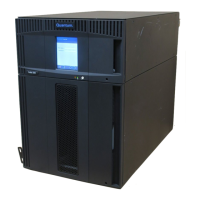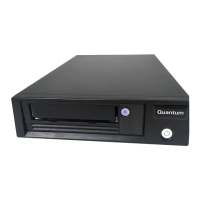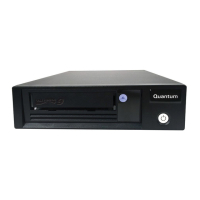Glossary
270 SuperLoader User’s Guide
S
SCSI Small Computer System Interface. An American National
Standards Institute (ANSI) interface between the computer and
peripheral controllers. Apple MacIntosh systems and many UNIX
operating system workstations use the SCSI interface.
scalability Refers to the capability provided by the DLT tape drive
family to read tapes from previous generations of drives. Allows users to
upgrade to a faster, higher capacity DLT drive, yet still be able to read
tape recorded on an older system. The term also refers to the ability of
DLT tape library systems to be upgraded with a higher performance DLT
drive and thus provide more capacity and performance in the same
footprint. See backward compatibility.
seek The movement of a read/write head to a specific data track.
self cleaning head Found in all DLT tape drives. Tiny ridges on either
side of the DLT drive read/write head continuously wipe the tape clean
as it passes over the head. This is why there is no periodic cleaning
prescribed for DLT tape drives.
server A powerful computer system with a large hard disk drive that
serves the information access and communication needs of multiple
users. Often servers are dedicated to a particular function such as Internet
access, printing, file management, backup, and network communications.
servo data Magnetic markings written on the media that guide the read/
write heads to the proper position.
shelf life The length of time that a tape can be stored without losing its
magnetic strength. For DLTtape media, this period is 30 years or more.
shock rating A rating, expressed in Gs which stands for multiples of
gravity, of how much shock a tape drive can sustain without damage.
Operating and non-operating shock levels are usually specified
separately.
SMTP Simple Mail Transfer Protocol. An e-mail protocol on the Internet
that defines the message format and the message transfer agent.
SNMP simple Network Management Protocol. A protocol that monitors
and controls a network.
SNTP Simple Network Time Protocol. SNTP is based on NTP, the
Network Time Protocol, an industry standard way for computers to
synchronize their time to an external reference standard. NTP and SNTP
are fully interoperable. Each consists of a client, for example the
SuperLoader, which obtains the current time (in UTC) from either an
SNTP server or an NTP one. SNTP and NTP are in wide use on the
Internet. NTP is specified by RFC1305. SNTP is specified by RFC2030.

